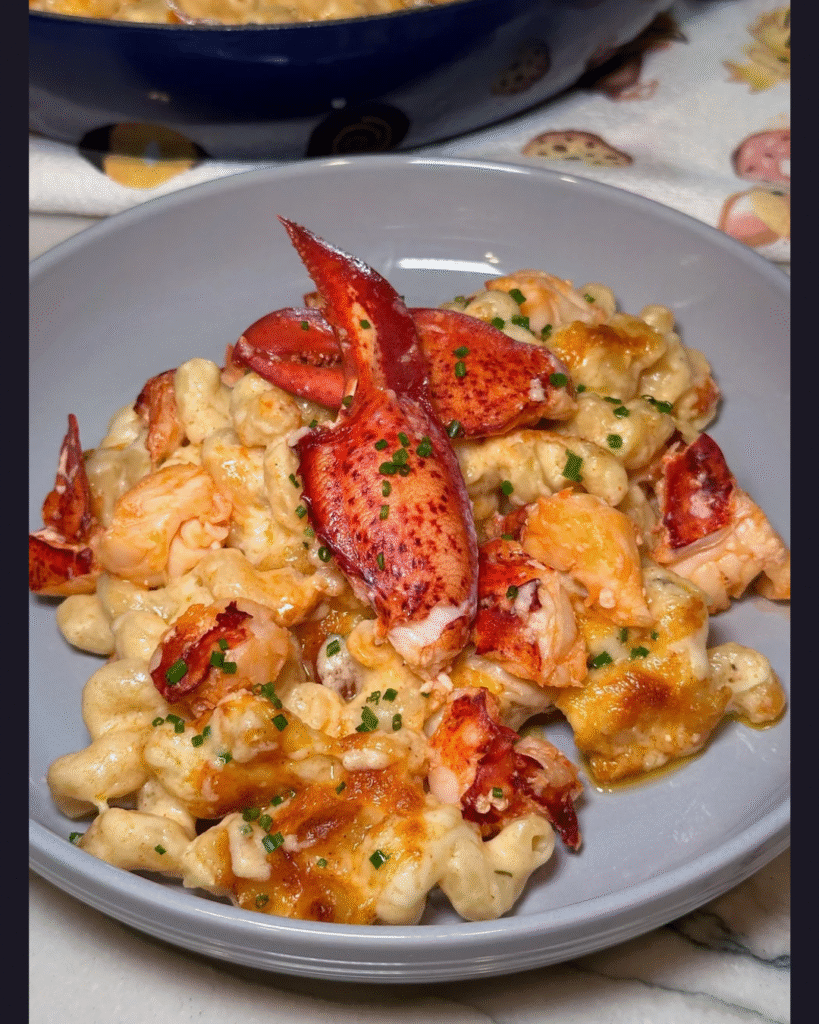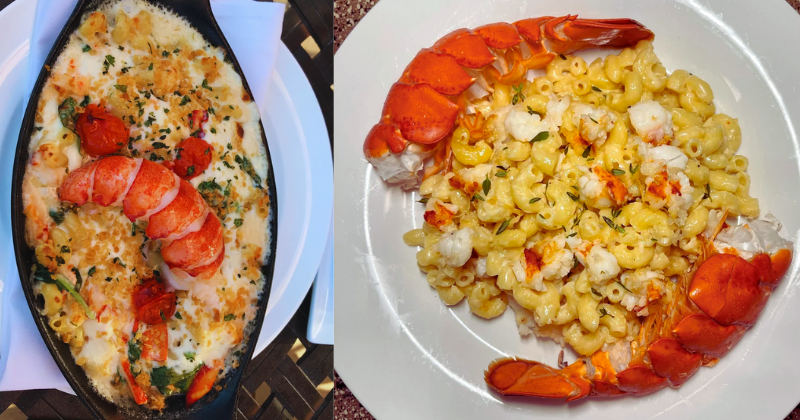Prep Time: 20 minutes/ Cook Time: 35 minutes/ Total Time: 55 minutes/ Difficulty: Intermediate/ Serves: 6-8 people
Table of Contents
There’s something magical that happens when you combine the humble comfort of mac and cheese with the luxurious sweetness of fresh lobster. I’ll never forget the first time my grandmother surprised our family with her homemade lobster mac and cheese during a special celebration dinner. The way everyone’s eyes lit up as they took that first bite – the creamy, rich cheese sauce perfectly complementing tender chunks of succulent lobster meat – it was pure culinary heaven. That moment inspired me to perfect my own version of this show-stopping dish, and today I’m sharing every secret I’ve learned along the way. This homemade lobster mac and cheese recipe transforms an everyday comfort food into an extraordinary centerpiece that’s surprisingly achievable in your own kitchen.
Why You’ll Love This Recipe
This isn’t your ordinary boxed mac and cheese – it’s a restaurant-quality dish that brings elegance to your dinner table without requiring culinary school training. First, the combination of three premium cheeses creates an incredibly rich and complex flavor profile that perfectly balances the sweet, delicate taste of fresh lobster. The homemade cheese sauce is silky smooth and coats every piece of pasta beautifully, ensuring each bite is pure indulgence.
What makes this recipe truly special is how surprisingly easy it is to achieve professional results at home. The step-by-step method breaks down what seems like a complicated dish into manageable stages, making it perfect for special occasions or whenever you want to treat your family to something extraordinary. Plus, this recipe is incredibly versatile – you can adjust the cheese blend to your preferences or even prepare components ahead of time for stress-free entertaining.
The wow factor is undeniable. Whether you’re hosting a dinner party, celebrating an anniversary, or simply wanting to elevate your weeknight dinner game, this lobster mac and cheese delivers the kind of memorable dining experience that has everyone asking for the recipe. It’s comfort food meets fine dining, and the results are absolutely spectacular.
Ingredient Insights & Selection
The success of your homemade lobster mac and cheese hinges on selecting quality ingredients, starting with the star of the show – fresh lobster meat. If you can find live lobsters, cooking them yourself ensures the sweetest, most tender meat. However, high-quality frozen lobster tails or pre-cooked lobster meat from a reputable fishmonger works beautifully too. Look for meat that’s bright white with no fishy smell, and plan on about 1 pound of lobster meat for this recipe.
For the cheese blend, I recommend combining sharp white cheddar for tang, Gruyère for nuttiness, and cream cheese for ultra-smooth texture. The cheddar provides the classic mac and cheese flavor we all crave, while Gruyère adds sophisticated depth. If Gruyère isn’t available, aged Swiss or even fontina makes excellent substitutions. Always grate your cheese fresh – pre-shredded varieties contain anti-caking agents that can make your sauce grainy.
Choose a sturdy pasta shape that holds sauce well. Large shells, cavatappi, or penne work wonderfully because their curves and ridges capture every bit of that luscious cheese sauce. For the base of your cheese sauce, use whole milk and heavy cream for the richest results, though you can substitute with half-and-half if needed. The key is maintaining enough fat content to create that silky, restaurant-quality texture.
Key Techniques & Method Overview
Mastering the perfect cheese sauce is the foundation of exceptional lobster mac and cheese. Start by creating a proper roux – a mixture of butter and flour cooked together until it’s golden and nutty, which eliminates any raw flour taste and creates the thickening base for your sauce. The secret is cooking the roux long enough to develop flavor but not so long that it becomes too dark and bitter.
Temperature control is absolutely crucial when adding cheese to your sauce. Always remove the sauce from direct heat before whisking in the cheese, and add it gradually while whisking constantly. This prevents the proteins in the cheese from seizing up and creating a grainy, separated sauce. If your sauce does break, don’t panic – a splash of hot pasta water and vigorous whisking often brings it back together.
The lobster requires gentle handling to maintain its delicate texture. If you’re cooking live lobsters, aim for just until the shells turn bright red and the meat is opaque. Overcooking results in tough, rubbery lobster that ruins the entire dish. Pre-cooked lobster should simply be warmed through gently in the finished sauce.
Assembly technique matters significantly for the final texture. Don’t drain your pasta completely dry – reserve some starchy pasta water to help bind everything together. Fold the lobster into the cheese sauce just before combining with pasta to prevent it from breaking apart. The final baking step should create a golden, bubbly top while keeping the interior creamy and sauce-like.

Step-by-Step Instructions
- Prepare your mise en place: Cook 1 pound of pasta according to package directions until just al dente, reserving 1 cup pasta water before draining. If using live lobsters, steam or boil them until bright red, then remove meat and cut into bite-sized chunks. Preheat your oven to 375°F and butter a 9×13-inch baking dish.
- Create the roux: In a large, heavy-bottomed saucepan, melt 4 tablespoons of butter over medium heat. Whisk in 4 tablespoons of flour and cook, stirring constantly, for 2-3 minutes until the mixture smells nutty and turns light golden. This eliminates the raw flour taste and creates your thickening base.
- Build the cheese sauce: Gradually whisk in 2 cups whole milk and 1 cup heavy cream, ensuring no lumps form. Bring to a gentle simmer, whisking frequently, until the sauce thickens enough to coat the back of a spoon (about 5-7 minutes). Season with salt, white pepper, and a pinch of nutmeg.
- Add the cheese: Remove the saucepan from heat completely. Gradually whisk in 2 cups sharp cheddar, 1 cup Gruyère, and 4 ounces cream cheese until completely smooth and melted. Taste and adjust seasoning – the sauce should be well-seasoned since it will be diluted by the pasta.
- Combine and assemble: Fold the cooked pasta into the cheese sauce, adding pasta water as needed for the perfect consistency. Gently fold in the lobster meat, being careful not to break it apart. Transfer to your prepared baking dish and top with additional grated cheese and breadcrumbs if desired.
- Bake to perfection: Bake for 20-25 minutes until the top is golden brown and the edges are bubbling. Let rest for 5 minutes before serving to allow the sauce to set slightly. Garnish with fresh chives or parsley for a pop of color.
Pro Tips & Troubleshooting
The key to silky cheese sauce lies in your cheese-to-liquid ratio and temperature management. If your sauce seems too thick, thin it gradually with warm pasta water rather than cold milk, which can cause separation. Conversely, if it’s too thin, create a small slurry of flour and cold milk, whisk it smooth, and add it gradually while cooking until you reach the desired consistency.
To prevent your lobster from becoming rubbery, add it to the dish during the final few minutes of assembly, not during the cheese sauce cooking process. The residual heat will warm it through perfectly without overcooking. When buying pre-cooked lobster, look for meat that’s been flash-frozen immediately after cooking for the best texture.
For make-ahead preparation, you can prepare the cheese sauce up to two days in advance and store it covered in the refrigerator. Reheat it gently while whisking in a splash of milk to restore the smooth texture. The assembled dish can be refrigerated overnight before baking – just add an extra 10-15 minutes to the cooking time.
If you notice your cheese sauce breaking or becoming grainy, immediately remove it from heat and whisk in a tablespoon of cold butter or a splash of hot pasta water. The emulsification properties often bring the sauce back together beautifully.
Variations & Customizations
Transform this recipe to suit different dietary needs and preferences with these simple modifications. For a gluten-free version, substitute the all-purpose flour with an equal amount of rice flour or cornstarch, and use gluten-free pasta. The cooking method remains exactly the same with equally delicious results.
Create a lighter version by using half-and-half instead of heavy cream and reducing the cheese by about 25%. Add extra flavor depth with a splash of white wine whisked into the roux, or incorporate crispy bacon pieces for a surf-and-turf twist. For those who enjoy heat, a pinch of cayenne pepper or a dash of hot sauce elevates the flavor profile beautifully.
Seasonal variations keep this dish exciting year-round. In summer, fold in fresh corn kernels and diced tomatoes. During fall, try adding roasted butternut squash cubes. For special occasions, enhance the luxury factor with a drizzle of truffle oil or a handful of fresh herbs like tarragon or dill.
Storage, Reheating & Make-Ahead Tips
Proper storage ensures your lobster mac and cheese maintains its quality for several days. Refrigerate leftovers in airtight containers for up to 3 days. When reheating, add a splash of milk or cream to restore the creamy consistency, and reheat gently in the oven at 325°F rather than the microwave to prevent the sauce from separating.
For longer storage, this dish freezes surprisingly well for up to 2 months. Freeze in individual portions for easy reheating, and thaw completely in the refrigerator overnight before reheating. The texture may be slightly different but still delicious.
Make-ahead preparation works wonderfully for entertaining. Assemble the entire dish up to 24 hours in advance, cover tightly, and refrigerate. Remove from refrigerator 30 minutes before baking and add 10-15 extra minutes to the cooking time. This strategy allows you to enjoy time with guests instead of being stuck in the kitchen.
Serving Suggestions & Pairings
This rich, luxurious lobster mac and cheese deserves equally thoughtful accompaniments that complement rather than compete with its decadent flavors. A crisp, simple salad with lemon vinaigrette cuts through the richness beautifully, while roasted asparagus or steamed broccoli adds fresh, green contrast.
For wine pairings, choose options that enhance the dish’s elegance. A crisp Chardonnay or Sauvignon Blanc provides beautiful acidity that balances the cheese’s richness, while a light Pinot Grigio offers clean, fresh notes that highlight the lobster’s sweetness. If you prefer sparkling wine, Champagne or Prosecco creates a truly celebratory dining experience.
Complete your meal with crusty bread for texture contrast and to ensure no drop of that amazing cheese sauce goes to waste. Consider serving this as the centerpiece of a special dinner alongside other elevated comfort foods, or present it as an impressive side dish for holidays and celebrations.
Ready to create your own memorable dining experience? Gather your ingredients, follow these detailed steps, and prepare to impress everyone at your table with this restaurant-quality homemade lobster mac and cheese that’s guaranteed to become a family favorite!

